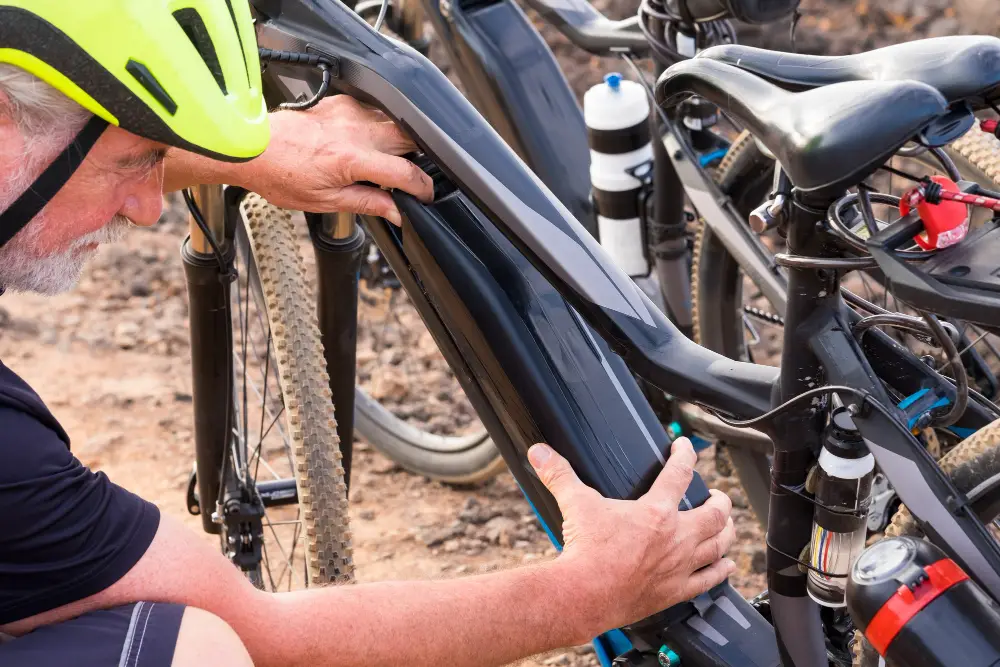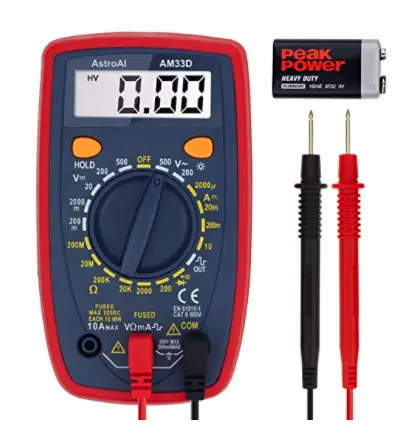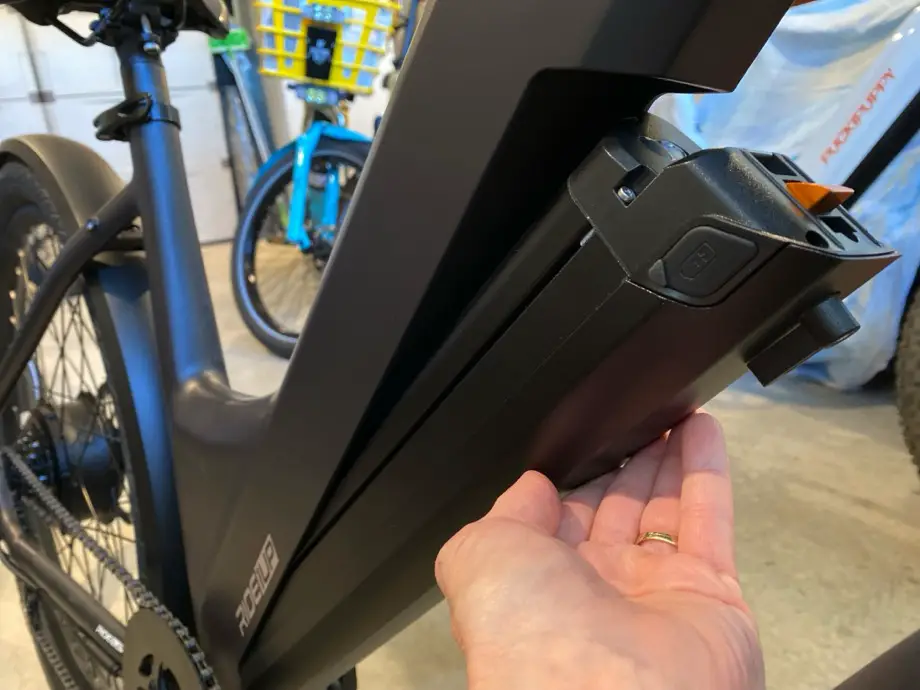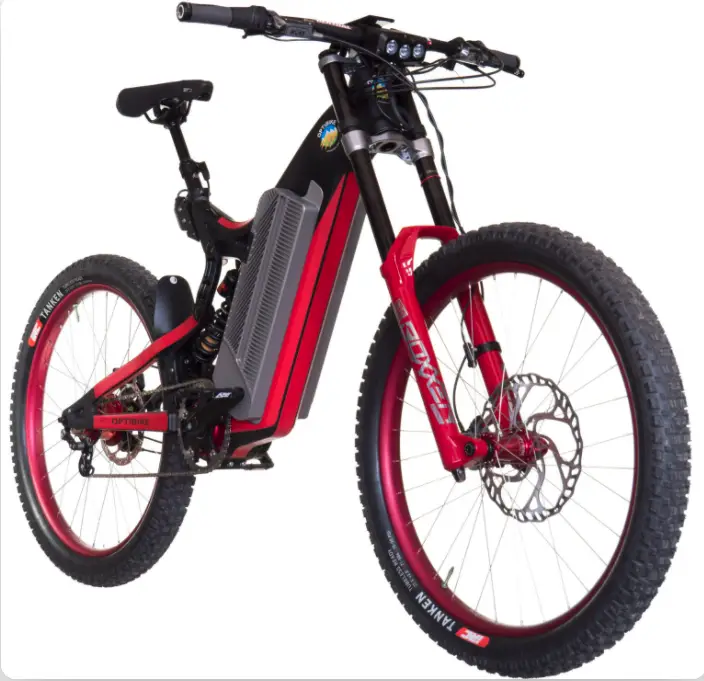Running a second battery in parallel can add additional speed and increase the ride duration of your e-bike, making it a tempting option for those looking to modify their current ride. However, the overall process of adding a second battery can be complex and leave you wondering if there is a way to do so safely.
You can add a second battery to your e-bike safely in parallel. The process of adding a second battery to your e-bike in parallel can be complicated, and you should do it carefully using batteries of the same voltage.
In the rest of this article, I will go over what happens if you connect batteries of different voltages and the pros and cons of adding a second battery. I’ll also offer a basic guide to connecting another battery on your e-bike in parallel and tell you some alternatives to installing a secondary battery.

What Happens When You Connect Two E-Bike Batteries of Different Voltages in Parallel?
When preparing to add a second battery to your e-bike, it’s essential to remember that a difference in voltage of your batteries does matter.
When you connect two batteries of different voltages in parallel, they will attempt to level out the voltage between themselves, resulting in significant problems such as destroying the batteries or starting a fire if the voltage difference is too substantial.
There are two ways that you can ensure that your batteries are of a similar voltage before attempting to connect them to your electric bike in parallel:
- Test the voltage with a multimeter. Using a multimeter is a fantastic way to get an accurate reading on both e-bike batteries and remove any guessing about how much voltage each battery contains. You can purchase multimeters like this AstroAI Multimeter (available on Amazon) relatively cheaply. These devices are helpful for many other purposes, and they’ll help provide peace of mind when connecting two batteries.
- Charge both batteries before hooking them up in parallel. Charging both batteries ensures that the voltages match and helps avoid mishaps like fires or battery explosions.

If you wish to be overly cautious, you could follow both steps, but completing either step should significantly reduce your chances of disaster when hooking up your e-bike batteries in parallel.
It is also important to remember that using batteries of the same voltage, make, and age is recommended for the best results when adding on a second battery.
You might also try adding a blocking diode to help prevent one battery from ruining the other if they decide to surge. Still, again, the best way to ensure that your batteries stay in working order is to make sure that they are adequately charged and at a matching Voltage (V), Capacity (Ah), and total Watt Hours (Wh).
You might wish to learn more about interchangeable batteries before you connect two in parallel!
The Pros And Cons Of Installing A Second E-Bike Battery
Since adding a second battery can be complicated, knowing if the benefits outweigh the cons is essential.
The Cons of Installing A Second E-Bike Battery
Let me first go over the cons of adding a second battery to your e-bike:
- Adding a second battery in parallel can be a bit complicated. Some people like to purchase pre-made parallel battery connector cables, while others prefer creating their connectors. The purchasable connectors appear to be the more straightforward method of the two, though some feel more comfortable making the connectors themselves.
- You can fry your batteries or even start a fire if done incorrectly. As we went over earlier, if your batterys’ voltages don’t match, if they aren’t the same make, or if they don’t have the same cell count, your batteries are at higher risk of breaking or worse.
- Installing a secondary battery is a lot of work when a bigger battery can accomplish more. A larger battery can hold more energy and is preferable over using two batteries in parallel if you can afford the upgrade.
- Charging two batteries can take a long time. Having two batteries means having double the charge times. A good fix for these wait times would be to purchase a second charger and charge both batteries at once.
- A second battery will add more weight to your e-bicycle. Depending on your specific electric bike and the batteries you have chosen, the added weight may be minor.
- You will have two batteries to maintain. Having two batteries on your e-bike means double the work since you will have to maintain them both.
So, there are a few cons when it comes to installing two batteries in parallel on your e-bike, the biggest one being how hard it is to do so correctly.
Still, don’t let that scare you if you genuinely have your heart set on adding another battery to your ride.
The Pros of Installing A Second E-Bike Battery
Next, I’ll take a look at the pros of adding a battery to your e-bike:
- Adding a second battery can be cheaper than purchasing a new one. It’s no secret that the larger bike batteries hold more juice and can run for longer, but they do cost more. So, adding a second battery to your e-bike is preferable if you have a tight budget.
- A second battery can give you up to two times more range. With a second battery, you will be able to travel further and at faster speeds, which is a huge benefit if you are a long-distance rider or touring.
Ultimately it’s up to you to decide if the pros outweigh the cons. Cost is an essential factor in upgrading your e-bike, and it’s much cheaper to add a secondary battery than purchase a larger one or buy a new electric bike. Although you can look into buying a cheaper electric bike.

How To Install a Second Battery on Your E-Bike in Parallel
If you want to increase your e-bike’s power or the distance your electric bicycle can travel between battery charges, adding a second battery in parallel is a great option. Adding another power source is ideal if you aren’t looking to spend a lot of money purchasing a larger battery.
E-bike batteries that have the same number of cells, voltage, and construction can be installed and run in parallel by using a parallel battery connector cable to connect the two batteries.
However, depending on your electric bike and batteries, this can be be a challenge. Each battery can come with different connectors, and some are more difficult to find the right adapters for than others.
What You Will Need To Install a Second Battery on Your E-Bike in Parallel
So, let’s dive into what you will need to install a second battery in parallel on your e-bike using a parallel battery connector cable.
You will need:
- A multimeter (Amazon)
- Two e-bike batteries with a similar make and the same voltage (check here if you want to rebuild an e-bike battery)
- A parallel battery connector cable
Step-By-Step Guide To Install a Second Battery on Your E-Bike in Parallel
Next, we’ll be going over the steps to attach your batteries using a parallel battery connector cable:
- Check the voltage of your two batteries. Your battery voltage must be the same; otherwise, you risk losing both batteries and possibly injuring yourself. If you don’t have a multimeter, you should make sure that you have fully charged both batteries.
- Acquire a parallel battery connector cable. This cable will allow you to quickly connect the two batteries to your electric bike. Depending on your batteries’ individual wires, you may need an adapter.
- Connect both batteries to the parallel battery connector. After connecting the two batteries, you can plug the connector into the electric bike. Still, keep in mind that it may need an adapter to plug straight into your e-bike.
- Mount your second battery on your e-bike. You will want to mount your second battery somewhere stable and out of the way.
- Enjoy your new battery power on your electric bicycle! Now it’s time to take a ride and see how you like your newly powered e-bike. You should now be able to enjoy longer rides and faster speeds.
If you are looking for more guidance on adding a secondary battery in parallel to your electric bicycle safely, here’s a helpful video you should check out:
Adding a secondary battery in parallel is complicated and should not be undertaken lightly. If done incorrectly, you can risk ruining your batteries, injuring yourself, or causing a fire or explosion.
That said, adding a secondary battery to your e-bike is not impossible with the right tools and research, and many people find this method preferable to purchasing a giant new battery.
Now that we have covered how to install a secondary battery for your electric bike in parallel, let’s talk a little about your other options.
Alternatives to Adding a Second Battery to Your E-Bike
For some, attempting to add a secondary battery to your electric bicycle might not be practical, and the idea might leave you feeling a little overwhelmed.
Not to worry! Adding a second battery isn’t the only way to get more out of your e-bike. There are several other options you might want to consider.
Try Carrying a Second Battery
Carrying around a second fully charged e-bike battery is one of the most highly recommended alternatives to mounting a second battery in parallel.
So, what makes lugging around a second battery on your rides a good idea?
The Pros of Carrying Around a Second E-Bike Battery
Some of the pros of carrying a secondary battery include:
- Setting up a second battery for use is easy. The simplicity of using a second battery makes this option so enticing. You simply need to purchase a second battery and make sure you have fully charged it before taking it out on rides.
- Carrying a second battery is an even cheaper option than adding a secondary battery to your e-bike. With this option, you won’t have to worry about purchasing additional cables or adapters and will only need the new battery and a good charger.
- Batteries are easy to carry around. A second fully charged battery can easily be stored in a backpack or mounted somewhere to the electric bike for later use.
- You will always have a backup battery. If something goes wrong with your primary e-bike battery, you will always have a backup to get yourself home safely.
As you can see, there are quite a few benefits to carrying around a second battery. This particular alternative is relatively easy, and many opt for carrying a secondary battery instead of installing two batteries in parallel onto their e-bike for just that reason.
The Cons of Carrying Around a Second E-Bike Battery
You may be thinking that’s great and all, but what are the drawbacks?
Well, here are some of the cons for carrying around a second electric bike battery:
- Longer charging times. With two batteries, you will experience double the charging time and may want to consider purchasing a second charger to speed this up.
- You will have to remember to pack the battery with you on your rides. A second battery shouldn’t take up too much space, but that doesn’t mean it isn’t frustrating to have to tote around.
- Double the maintenance. You will have to take care of and maintain two batteries instead of one.
In all honesty, carrying a second battery out on your rides isn’t a bad option for those who aren’t interested in the time, money, or safety considerations it takes to mount a second battery in parallel… or who don’t want to purchase a new e-bike.
Purchase a Larger E-Bike Battery
The second alternative to adding a secondary battery to your electric bicycle is to purchase a newer, larger battery. A larger battery is technically superior to mounting two batteries on your e-bike in parallel, though not everyone has the budget for a new big battery.
The Pros of Purchasing a Larger E-Bike Battery
So let’s take a look at some of the reasons you might consider purchasing a large battery instead:
- Replacing your smaller e-bike battery with a large one is pretty straightforward. Switching your small battery out for a larger one is simple and shouldn’t require a lot of adapting, depending on the battery you upgrade to.
- A larger battery is more powerful. The larger battery’s ability to hold more energy will give you a more extended range.
- One battery charge time. You will only have to worry about charging one battery before heading out on a ride.
The Cons of Purchasing a Larger E-Bike Battery
These all sound pretty nice but let’s take a look at some of the drawbacks to having a bigger e-bike battery:
- Larger batteries cost more. Purchasing a new bigger battery can be a bit pricey, and if you don’t wish to spend that kind of money on your e-bike, it can be a deal-breaker for you.
- Placement for a big battery can be tricky. Placing a bigger battery on your electric bike can be tricky since you don’t want something big and clunky to bump into as you ride. Each battery model will be different, so be sure to find something that will fit your frame snugly.
So there you go. Purchasing a larger battery bank is preferable if it’s within your budget, but it is certainly possible to achieve similar results by adding a second battery in parallel.
Add Solar Panels
Consider adding a solar-powered system for charging your e-bike! Instead of worrying about the cons of adding an additional battery, use solar power. This will save you money on electricity and let you charge your bike just about anywhere you go!
Use a Generator
You can use a generator to power your e-bike. As long as your generator has enough watts to fully charge it, you just need to plug it into an outlet like a regular bike charger.
Use a Car Battery Inverter
Believe it or not, you can charge with a car battery as long as you have an inverter and 12V power outlet. But to stay safe, you should find out more about using a car battery as a bike charger first.
Purchase an E-Bike That Already Comes With a Large Battery
Last but not least, you might consider purchasing a new e-bike, provided it’s within your budget.
Many brands and models of e-bikes are readily available, and some of them may provide longer-ranged rides with more powerful batteries.
But here are two highly recommended e-bikes with excellent battery life.

R22 Everest
First, we have the R22 Everest. This bike is extremely high-priced but seems to have spared no expense regarding the quality and design.
This electric bicycle is an excellent option for people who aren’t on a budget (starting price around $18,000).
Some of the specs of the R22 electric bike:
- It has a 300 mile (482.8 km) travel range. The creators of the R22 Everest claim that this bike’s battery and motor are so powerful that it could make its way up Mt. Everest in a single charge.
- It has a 3260Wh Removable Dual Battery. That means that if one battery goes out on your ride, you still have a second battery that turns on, so you will hardly ever run out of charge.
The price is certainly something that won’t fit everyone’s budget, but if you are looking for an electric bike with a ton of power and battery life (no worry about what to do if your e-bike battery dies in the middle of a ride), this just might be the ride for you.
Super Monarch
The Super Monarch is a pretty decent option for those whose budget is a little tighter (starting at $3500). The Monarch is an excellent option with a good range and a dual battery.
So let’s take a look at what makes the Super Monarch so great:
- It’s relatively budget-friendly. There are cheaper e-bikes on the market, but the Monarch seems to offer more than most at a great value.
- Can travel over 80 Miles (128 km) with pedal assistance. This kind of distance makes it an excellent option for cross-country biking.
- It has a twin battery, twin motor, and twin suspension design. Having a second battery to pull the weight if the other goes out offers a lot of peace of mind when out on a long ride. Just make sure you safely charge the batteries overnight before a long ride.
For the price, this bike is honestly a great option if you are considering purchasing a new e-bike rather than trying to add on a second battery in parallel.
Conclusion
The overall process for adding a second battery to your electric bike is complicated but certainly not impossible. You will need a few tools such as a parallel battery connector cable and two batteries of the same voltage of matching ages and make.
So honestly, if you are considering upgrading your e-bike to have a secondary battery and feel confident in your ability to do so, you should go for it. Having an additional battery to count on should your first one fail is always a comfort and can help you get home safely in a pinch.


